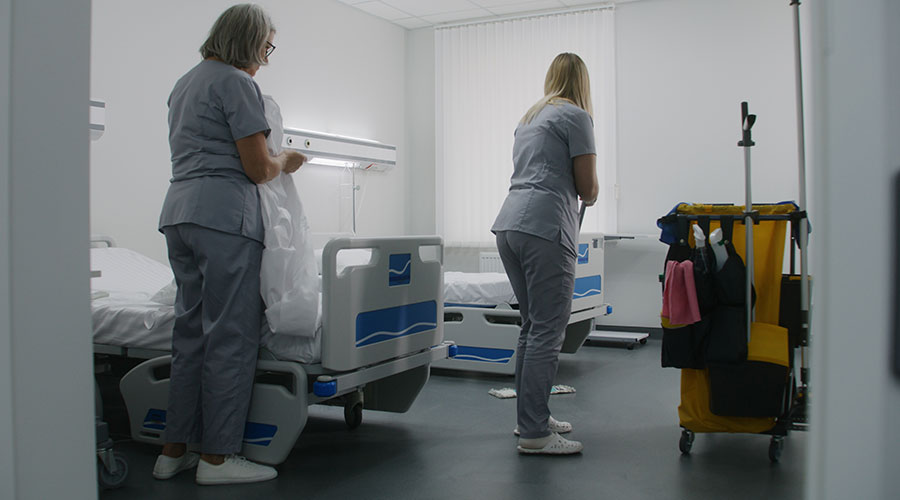Today more than ever before, healthcare centers have become significant economic engines in their communities, particularly in rural settings. As business owners, healthcare organizations are important contributors to local economies. Leadership of these organizations must embrace this demanding role and the responsibilities it entails, which present a challenge comprising both opportunity and risk.
Successfully meeting this challenge requires that organizations implement fundamental changes in healthcare services delivery, operations and facilities. Flow and value mapping are valuable tools for the implementation of Lean transformation of all processes. Application of Lean principles involves the elimination of all forms of waste: overproduction, wait, transport, inappropriate process, inventory, movement/motion and defects. Improvements in operations and facility design enable healthcare organizations to transform the patient-customer experience. The operational gains and increased efficiencies generate additional revenue and free up resources that can be invested in community wellness and prevention services as well as enhanced amenities.
Healthcare organizations in Othello, Washington and Tahoe, California are leveraging wellness center transformational solutions to generate benefits for the organizations, for the patients they serve, and for the communities in which they are integral members.
Small and rural city economic engines:
Community Health Center, Columbia Basin Health Association, Othello, Wash.
Beyond geography, small and rural cities like Othello are characterized by size, demographics and employment sources. Othello is an agrarian center with a large Hispanic workforce. With 10,000 inhabitants, it is the largest city in the county, representing half of the total population.
Columbia Basin Health Association (CBHA) is the largest, non-hospital, health provider in the region, delivering services to the overall catchment population of 150,000. CBHA provides outpatient care programs from primary to specialty care, including behavioral, nutritional and dental services. With over 350 employees, CBHA is the 4th largest employer in the area.
Health expenditures nationally average above $9,900 per capita, totaling $3.2 trillion or 17.8% GDP (Source: CMS, Dec. 6, 2016). In Othello, as in other cities across the country, these expenditures must be retained locally to fuel economic growth and diversification.
The expansion of healthcare facilities and associated market growth is always a critical consideration for leaders. The original intention of CBHA leaders had been to replace the existing clinic following the traditional approach — that is, replacing existing space with a modern environment allowing for market growth as well as some limited expansion of services.
Recognizing the industry shift — moving from individual caregiving to providing community wellness and away from organization-centric to patient/customer-focused experience — CBHA’s leadership and their architect/planners understood that improving internal operational and financial performance demanded reaching beyond the original project objectives, and they sought development of a transformational solution. They determined that beyond healthcare, the new facility also must become a wellness destination; the additional objective was to transform the medical center into an economic engine for the region.
CBHA was not able to formalize a strong partnership with the City of Othello as had been desired, and full integration with city and county wellness services could not be achieved in the new facility. Nevertheless, the Community Health Center (CHC) master plan included: on-site residential units; expansion and parking for a future comprehensive wellness center; community-oriented retail and public environments; a public plaza and an exercise trail.
The facility solution resolved operational variables, services delivery model variables, and process transformation through leveraging of the EMR and other digital technologies and Lean facility design principles. The service philosophy shifted the focus of processes from organization-centric to patient/customer-centric, and away from individual episodic care to population- and community-based prevention and wellbeing.
Lean philosophy operational principles and design strategies were applied to introduce multidisciplinary care teams. As a result, the architectural solution modifies individual provider work spaces and eliminates wait and all other forms of waste by leveraging digital technologies, optimizing flows, increasing utilization and increasing efficiencies.
Eliminating private offices. Technology and teamwork have transformed work flows and work location across the healthcare industry. Indeed, teamwork philosophy is here to stay, not only in healthcare but all industries. The design group recognized that providers and staff members need private work spaces, but these need not be in large private offices. In a multidisciplinary care team environment, they also need collaborative work space. The design team implemented solutions for all three of these work activities.
Eliminating the waiting room. The waiting room is an emblem of and excuse for an antiquated process. Under patient/customer-centric design, all wait must be eliminated. This requires that all processes and resources must be properly sequenced. For example, a 10:00 a.m. appointment must include the processes of information exchange, greeting, and treatment and discharge, as well the space, providers and equipment (resources) at that time and point of care.
Creation of community-oriented spaces. Spaces for meeting, education, exercise, recreation, dining, etc., are frequently included in medical facilities. Sharing these physical environments with the community leverages the high traffic associated with medical offices to achieve lower occupancy costs/rents that help defray the costs of amenities such as walking trails and public plazas.
The exercise trail and plaza at the CHC are symbols and evidence of CBHA’s community commitment. These elements complement the destination objectives and add to the vitality of the new wellness center. Eventually, these amenities become community resources.
The regional employment gains — approximately 150 jobs during the construction phase of the CHC, as well as additional staff positions — are significant benefits representing an investment in and lasting impact on the region’s economy.
Wellness Destination as a cty economic engine:
Robert Maloff Center of Excellence, Tahoe, Calif.
Tahoe, a magical natural setting and world-renowned city for skiers and other outdoor enthusiasts, provides unique advantages and opportunities for the creation of a wellness destination. Indeed, Barton Health has commenced construction of the Robert Maloff Center of Excellence where orthopedics, training, fitness and prevention services will be offered.
Tahoe is among the more regulated construction areas in the country. Its natural beauty requires compliance with strict protective measures. Land availability and land use regulations further manage growth. As a result, facility development is quite challenging.
The Barton Health hospital campus houses the Tahoe Center for Orthopedics, a nationally recognized, comprehensive program for orthopedic excellence focusing on quality and patient-centered, personalized care. The hospital will consolidate and integrate wellness-related services to optimize access and services delivery, without duplicating costly, hospital-based services and equipment in the Maloff Center. A formerly adjacent wellness and fitness training center will also be incorporated into the new facility. Lastly, high-altitude training programs will offer the market carefully defined athletic development and instruction with associated service lines.
Barton Health, recognized as a Top Performing Hospital by the Joint Commission, has always embraced community wellbeing. “The Robert Maloff Center of Excellence is changing the face of healthcare in our community: moving from a reactive healthcare model based on treating illness and injury to a proactive model using prevention and education,” said Chris Proctor, MPT, administrative director, Barton Health.
Building the new Maloff Center was made possible because of its namesake's generous donation. Overcoming planning and land considerations and managing the permitting sequences were critical, adding complexity and other challenges to securing project funding.
“Doing more with less” became a guiding principle. When funding sources are donations, greater responsibility and accountability often follow. Complex, ambitious and transformational projects such as this require collaboration, integration and the absolute commitment of all stakeholders. Tahoe regional planning officials, city leaders, hospital staff and the community joined arms to enable the realization of this facility.
Lean design enabled seamless integration of all services, which is a key component and driver for the successful operation of a community wellness center. The introduction, application and better use of modern digital technologies are essential in leveraging Lean design and sustaining active communication between caregivers and customers at the Maloff Center.
The shift to metrics-based decisions
Healthcare organizations recognize the imperative to improve access, deliver superior quality, maximize safety and lower costs through transformative organizational and facility solutions. The shift to metrics-based decision-making is a fundamental precept in these transformational change initiatives and the application of Lean philosophy and principles to facilitate them. As digital tools such as EMR have been deployed, it has become much easier to gather, develop and apply accurate organizational metrics.
Accurate metrics provide an objective basis for conversations with staff and leader groups. For example, when a doctor is informed that the face-time metric for a patient encounter is under 10 minutes — an assessment supported with grounded data — setting utilization targets becomes significantly easier. It is also critically important to make these organizational metrics public, as transparency ensures performance.
The country's aging population, current economic conditions and technological advances are the major forces that are driving the healthcare industry’s growth. In addition, the emphasis on wellness has contributed to market demand for new services. Traditionally, major cities have supported geographically and economically well-defined medical zones and sectors, which contribute to local and regional economies. Today, in smaller markets and rural communities, medical/wellness facility developments are becoming essential economic activity nodes — often the dominant ones — and these are becoming powerful economic engines.
Miguel Burbano de Lara, AIA, NCARB, has worked at The Neenan Company since 1999, where he focuses on Lean theory, design innovation and accelerated transformational project delivery. For additional information, please visit www.neenna.com.

 Disinfectant Dispensers in Healthcare Facilities Often Fail to Deliver Safe Concentrations: Study
Disinfectant Dispensers in Healthcare Facilities Often Fail to Deliver Safe Concentrations: Study Duke University Health System Receives $50 Million for Proton Beam Therapy Center
Duke University Health System Receives $50 Million for Proton Beam Therapy Center UT Southwestern Experiences Data Breach Through Calendar Tool
UT Southwestern Experiences Data Breach Through Calendar Tool Protecting Patient Data: Strategies and Tactics
Protecting Patient Data: Strategies and Tactics Duke Health to Acquire Lake Norman Regional Medical Center
Duke Health to Acquire Lake Norman Regional Medical Center